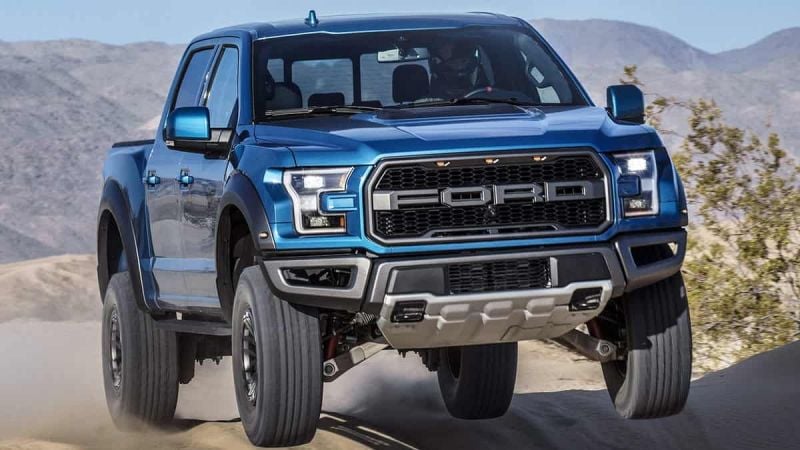How many times have you wondered, when you are filling up your Ford F150's fuel tank, whether it is better to run on 93 or 87 octane? The guys at Car & Driver wondered about it too and the results may amaze you. But, before we get to that particular reveal, let's talk about gasoline and octane. And, while we are at it let's also discuss a bit of the history of octane, as well.
Ford F150 EcoBoost Gassed Up
Let's begin with a chore that most of us do all the time, filling up the gas tank of our particular vehicle. Since we are discussing Ford F150s, we'll assume that we are filling the gas tank of a Super Crew Ford F150 Raptor. Though the Raptor can run on regular gasoline 93 octane premium is a better choice since the engine is the turbocharged EcoBoost 3.5-liter V6.
Though premium is better in the Raptor, you may have had some doubts because there is a significant price difference between regular and premium? Frankly, you may have wondered if continuing to put premium into the tank is worth it.
For some people, the answer is a definite no; gas is gas. Meanwhile, for others, the answer is a strong yes. Premium gas makes a difference in performance.
By now, you may be wondering where octane came from and what makes it so important? Octane had its beginnings around the time the auto industry began adding tetraethyl lead to gasoline. Though the vehicles at this time had fairly low compression ratios of maybe 6:1 or 7:1 when you pushed the vehicles their engines knocked. Tetraethyl lead served two purposes it was added to prevent knocking and to assure that if there was any knocking the upper cylinder areas would not be damaged as they were made of very soft metal. The tetraethylead acted as a lubricant.
Octane Is Introduced to Motoring Public
This introduced the concept of octane to the motoring public. At this point, most operators didn't know the meaning of octane. They knew it had something to do with the performance of their cars, but not much else. The public didn't know that octane was a measure of a fuel's resistance to knocking. Given the engines of the day, that were essentially cast iron, excessive, violent knocking which could have been catastrophic. You see, knocking created stronger in-cylinder explosions that could have caused lots of damage the motors of that day -- the mid-1920s. Octane had an added benefit as well. As the octane climbed and gasoline became purer -- a benefit of higher octane -- cars and trucks performed better. Octane was not only the measure of anti-knocking, but it also gained its alternate function, it was a predictor of performance.
All of this background is well and good, but, you may wonder what it has to do with the performance of your Ford F150. Car & Driver also wondered about this recently. The folks at C&D took four popular vehicles, including the Ford F150 Raptor, and set them up for testing. The Raptor uses Ford's top-end engine to drive the wheels, the turbocharged EcoBoost 3.5-liter V6.
The engine has a power rating of 450 horsepower with 510 pounds-feet of torque. C&D measured the power potential and determined that the engine cranks out 128.7 horsepower per liter. As an example of the Raptor's power, a Florida track group let a Raptor go over a with the big Blue Oval pickup powering through at 134 mph.
And, The Findings Are
Finally, we are at the point of the whole story, the result. Which gasoline octane performed better?
With the fuel tank filled with 93 octane gasoline, the Ford F150 turned in a 0 to 60 run in 5.3 seconds. It is quite an impressive achievement when you consider that the Ford F150 weighs nearly three tons (5,594-pounds). When the C&D crew switched over to 87 octane fuel performance dipped noticeably. The Ford F150 lost 20 horsepower and half-a-second on the track.
Watch Ford F150 Police Responder pickup truck and click to subscribe to Torque News for daily Ford and automotive news analysis.
Watch news about the Ford F150 Pickup News and the latest about its performance Click To Subscribe To Torque News YouTube Channel For Daily Ford and Automotive Industry News Analysis.
Here is a list of the results:
- 87 octane 0 to 60 run: 5.9-seconds
- 93 octane 0 to 60 run: 5.3-seconds
- 87 octane quarter-mile time: 14.5 seconds
- 93 octane quarter-mile time: 14 seconds
- Speed trap findings: 4 mph difference
- 87 octane shows 1.9 psi dip in turbo response
So what do the findings mean? You don't have to be an engineer to see that 93 octane gasoline outperforms 87 gasoline. To show this more clearly C&D performed a real-world test that proved premium gasoline performs better. They took the vehicles used for testing to an interstate where they set the cruise control to 75 mph. Cruising at 75, the testers found that premium (93 octane) gasoline returned 17.6 mpg. When they changed the fuel to regular (87 octane), they found that the Ford F150 with the EcoBoost powerplant achieved 17 mpg, a difference of .6 mpg.
Ford F150 Owner Will Pay More For Performance
So what does this all mean? It means that if you opt for premium fuel, you will be spending more at the pump because the higher-quality gasoline is much more expensive than 87-octane regular. Think of it this way, though you may be spending more at the pump, you are gaining better performance from the higher octane gasoline.
Follow Marc Stern, the Ford F150 Reporter for Torque News with news and tips about Ford trucks at @iraradioguy or on Facebook at mstern001.
Source: Car & Driver













Comments
good lord. This was by far
Permalink
Good Lord. This was by far one of the most painful articles I've ever read! Do you proofread before hitting publish? Did you take basic grammar classes in high school? Holy crap.... Please..... Hire an editor or stop writing.
Grammar police were defunded
Permalink
In reply to good lord. This was by far by Sean (not verified)
Grammar police were defunded . Go get a life .
Awesome article by the way .
No excuses, I blew all of the
Permalink
No excuses, I blew all of the issues, but I did fix them.So, while you have a right to be upset, chill, because it is much better if you read it now. And, yes I did take grammar courses in elementary, middle, and high school, despite what you may think.
Have you read it, really? It
Permalink
In reply to No excuses, I blew all of the by Marc Stern
Have you read it, really? It is no better, possibly worse. Typos, comma splices, wrong punctuation.... I just read your bio... there’s no way you’ve been writing for 20+ years professionally unless you’re doing so drunk now.
ROFL! Truth...terrible and
Permalink
In reply to Have you read it, really? It by Sean (not verified)
ROFL! Truth...terrible and extremely difficult to read. I guess it had the content I was after (thanks Google), but geez... I thought after a few sentences it was just another ripoff site.
I have read it, and, indeed,
Permalink
I have read it, and, indeed, I made corrections. By the way, there's no need for nastiness. I haven't been nasty to you, have I?
True, there is no need to be
Permalink
In reply to I have read it, and, indeed, by Marc Stern
True, there is no need to be nasty, Marc. The internet has created an enormous number of published writers, but we no longer have editors. There is still some type of Banner at the top of website, and that's who you write for. You are their voice. So rather than be another one of those writers who pack the internet, be an editor, too. Read your work before you publish it. You still have issues with comma splices, misplaced commas, basic sentence structure, etc. that could easily be cleaned up. I know the article was about gas, but it was written in English. Thanks, Marc. Ray Byrnes, PhD (English Literature).
"At the top of THE website".
Permalink
In reply to True, there is no need to be by Ray (not verified)
"At the top of THE website". Maybe? ;P
And yet the engineers still
Permalink
And yet the engineers still maintain and recommend using 87 octane. I started using 93 when I bought my '16 KR S-crew FX4 with 44K on the odo. Initially felt like it was running better but months into it that changed and it felt sluggish. Still good but sluggish. At 77.5K it began stumbling at stops after it was up to running temp and would sometimes die. No CEL or codes. Consistently ran at 450-500 rpms at stops during this period. CEL finally came on, right bank stuck at -30 degrees. Reset timing cleared code. Less than a week later, CEL on but running okay between stumbles. Replaced 8 VCT solenoids and all 8 plugs and boots. Less than 5 miles later it stumbled again. Then next day, CEL / misfire / stuck at -30 degrees. Cleared code and in less than 5 miles it stumbled again. Recommendation this time: both phasers to the tune of $4K. Told them I'd think about it. Next day, CEL on but only random stumbles, no dying. Only cleared code this time because it felt like it was running better. 250 miles later only 1 stumble and running like a scalded ape again. RPM's consistently @ 550-600 at stops after running temps achieved.
The exception? After the 2nd visit to the shop I switched back to 87 after being reminded by my service advisor that 87 octane was what the manual called for. Tank was diluted +/- 50% with 93 at that point. Probably in the range of 10% dilution now, nominal by the next time I top off. (35 gal tank topped off @ +/- 1/2 tank)
I'm not an engineer but my thought is that the system is retarding too much to compensate for the 93 (slower burning) fuel. Have to throw older parts into the mix as well. I'm guessing your test vehicle was new?
Again, even at the current 12:1 compression on the 2018 5.0's, the engineers still recommend 87 which is what I'm sticking to.
The engineers made the engine
Permalink
In reply to And yet the engineers still by Jeff (not verified)
The engineers made the engine capable of running on 87 octane, that is different than recommending it. Your experience and the timeline you state with the problems and clearing up is consistent with getting a bad tank or two of fuel and correcting it with fresh fuel. This is more likely to happen when purchasing premium as it has the least turnover at a gas station so it sits in their tanks longer. Did you try premium from different stations before going back to 87? I'm one that is guilty of hitting the same station every time, but it is a high traffic one.
This is directly from the owner's manual and covers all engine options:
"Your vehicle is designed to operate on regular unleaded gasoline with a minimum pump (R+M)/2 octane rating of 87.
Some fuel stations, particularly those in high altitude areas, offer fuels posted as regular unleaded gasoline with an octane rating below 87. The use of these fuels could result in engine damage that will not be covered by the vehicle warranty.
For best overall vehicle and engine performance, premium fuel with an octane rating of 91 or higher is recommended. The performance gained by using premium fuel is most noticeable in hot weather as well as other conditions, for example when towing a trailer."
Chassis dynos and knock monitoring have proven the superior performance of 93 vs 87 in the EcoBoost.....especially once ambient temps rise above 80 degrees. Now, is it absolutely required for everyday driving? That's up to the owner to decide.
The owners manual actually
Permalink
In reply to The engineers made the engine by Stymie (not verified)
The owners manual actually says "we recommend regular unleaded gasoline with an octane of 87.
No, it actually does not.
Permalink
In reply to The owners manual actually by Brian (not verified)
No, it actually does not.
The exact wording is:
"Your vehicle is designed to operate on regular unleaded gasoline with a minimum pump (R+M)/2 octane rating of 87.
...
For best overall vehicle and engine performance, premium fuel with an octane rating of 91 or higher is recommended."
The statement of being designed to operate with a minimum octane rating is not a sole recommendation of said octane which is why they do not use the word " recommend". It is a statement to not use fuel with an octane rating lower than 87.
'01 4.6L purchased in '03
Permalink
'01 4.6L purchased in '03 with 30k on the odometer. 93 octane was and still is my go to gasoline. 158k miles later (and knocking on wood)
no ill effects.
Replaced valve cover gaskets several months ago and found cams etc looking as pristine as the day they were installed.
0401 code proved to be nothing more than a leaking vacuum hose.
True, 93 is costly but in my experience, well worth it.